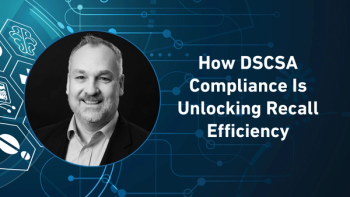
- Pharmaceutical Commerce - September/October 2013
A conversation with John M. Gray, Healthcare Distribution Management Assn.
The Healthcare Distribution Management Assn. is the lead trade group for what it calls “primary” wholesalers—the companies that acquire products directly from manufacturers, and then distribute to retail pharmacies, hospitals and clinics throughout the US. The formal scope of the association is US trade, although some of its members have international operations and, as will be seen here, this globalization is affecting HDMA’s outlook.
HDMA, founded as the Western Wholesale Druggists’ Assn. in 1876, became the National Wholesale Druggists’ Assn. in 1882, and took its current name in 2000. HDMA’s 32 members distribute nearly 90% of all pharmaceutical products in the nation, and derive 98% of their revenue from that distribution activity, according to the association’s annual Factbook. They send products from approximately 150 distribution centers to more than 200,000 locations—and do that, on average, five days a week. Pharmaceutical Commerce sat down with John Gray, president and CEO of the organization, to get his views on the past and future of drug wholesaling. Here’s what he had to say.
1. You’re coming up on 10 years as head of HDMA. How has the organization and its mission changed over that time?
I came on in 2004, from many years as an executive with the International Foodservice Distributors Association (formerly Food Distributor International) and before that, the Grocery Manufacturers of America. Like pharma wholesaling, the food business has significant logistics and supply chain management issues, and I got a lot of experience dealing with things ranging from shipping-pallet standards to barcoding. Although my education was mostly in law and business, this work has challenged me to be knowledgeable about supply chain issues.
2004 was the year that drug diversion and pedigree became a hot topic, and just as I joined, the state of Florida was in the midst of implementing one of the most robust pedigree programs in the nation. While there had been concern from some supply chain stakeholders, eventually, a system that the wholesaling industry could live with was established, passing almost literally at the stroke of midnight in 2006. Pedigree and track and trace—now focused mostly on California’s 2015 mandate and the action on Capitol Hill—have been a constant concern over the years.
Pedigree also figures in a big change our association underwent in 2005. As more and more states began implementing their own pedigree standards, we shifted our membership to focus solely on the primary wholesaling market, no longer including secondary wholesalers. This membership rule change resulted in a decrease in our membership, from around 90 members to the low 40s (consolidation among those companies leads to our current membership of 32).
2. I guess it’s inevitable that pedigree and now, traceability technology, would come up early in this discussion. What is HDMA’s position on the current legislative efforts in Washington? (Ed. Note: at the time of this writing, Congress had just gone on recess with bills in both houses under active consideration)
The biggest issue is getting a national program in place, because without that, we’ll be dealing with 50 different state programs. Can you imagine trying to produce a different product label for each of the 50 states? We are now tantalizingly close to getting this done. The biggest hurdle on the industry side has been getting all three sectors of pharma distribution—manufacturers, wholesaler/distributors and retail pharmacy—together, through their involvement in the Pharmaceutical Distribution Security Alliance. (Ed. note: HDMA, along with PhRMA, GPhA, BIO, NACDS, NCPA and many individual manufacturers and wholesalers, are members of this consortium.)
A bill has passed the House (H.R. 1919), and there is one in the Senate (S. 959). There has been criticism of these bills because they require drug traceability initially at the lot level, and not the item level until Phase Two; and the timetables for implementation. But I say, the legislature does its work by setting the overall goals, and then the private sector will kick in with higher performance standards in a competitive marketplace. Lot level traceability is a step in the right direction, and both bills get to item level tracing over time. I think passage of these laws is now more a question of “when” rather than “if.”
There’s one other regulatory issue that’s important to mention: drug diversion and the problem of drug abuse. We’d like to see a more collaborative effort, where manufacturers, retail and distributors could sit down together with the Drug Enforcement Administration to work out a better way to deal with these issues. DEA has had a recent policy of attempting to choke off access to abused drugs by going after distributors and retailers. It’s not clear that that is making any difference in addressing these problems, and at the same time, it creates difficulties for access for needed drugs for healthcare providers and their patients. Again, we’d like to work on these problems collaboratively with regulators, but that hasn’t happened yet.
3. Where does the basic relationship between manufacturers and HDMA members stand today?
It’s interesting—when I came on board at HDMA and for the next few years, we held discussions with pharma CEOs on track and trace, and just couldn’t get their attention. Back then, manufacturers thought they had little to worry about regarding their supply chains. That’s changed over the years. Part of this is due to the debate over drug traceability, and part due to the growing importance of global operations in pharma, where supply chain issues are critical.
Starting in 2007, and every two years after that, we’ve sponsored a study by Booz & Co. (Ed. note: “The Role of Distributors in the US Healthcare Industry”). The latest study shows that the wholesale distribution industry provides the healthcare system the equivalent of $42 billion in savings, compared to if pharma manufacturers handled distribution themselves. When this first came out, many thought it was a self-serving document—that was a time when the industry was converting to a fee-for-service basis, and there were a lot of mixed feelings. But we said, “You can question the numbers, but not the logic—put your own distribution cost numbers in and see.” When the second and third editions came out, there was much less questioning of the value proposition we were making.
It’s interesting, too, that while PhRMA and GPhA have roughly 75 members combined, we have 145 pharma manufacturers as associate members. They value our meetings and research as educational forums and as sources of best practices in pharma distribution, in such issues like cold chain management or returns processing. Manufacturers are more aware of logistics and supply chain issues than they were a decade ago.
4. Of the products handled by primary distributors, roughly 90% goes through the Big Three (McKesson, Cardinal Health, AmerisourceBergen). Does this concentration create problems for manufacturers?
These things go through cycles. Consolidation has been happening in wholesale distribution for quite a while now—and that’s not unique to our industry. Look at the US airline industry, or my former industry, food distribution—or the pharma industry itself, for that matter. A longer view of business history shows that there are periods of such concentration.
Today, there’s tremendous change occurring in specialty pharma, both for us and for manufacturers. Time will tell where all that will sort out. I would say, never count out independents. Regional players can thrive in this environment and I believe that those who stick it out will be glad they did.
5. Some HDMA members are expanding internationally. Will HDMA follow suit?
We’ve got several things going on right now. My intention is to have HDMA build a global scope going forward. For the past several years, we’ve sent a team of HDMA staff to World Health Organization meetings, and they’ve had a beneficial educational impact on discussions occurring there. Additionally, for the past couple years, we’ve had international groups, including the International Federation of Pharmaceutical Wholesalers and CAPDM, the Canadian Assn. of Pharmaceutical Distribution Management, attend our annual Distribution Management Conference. They come because they want to learn from the US supply chain experts that participate there—the same reason that representatives from pharma manufacturers participate.
Negotiations are under way right now to hold an international distribution-management meeting in China next year. IFPW will be holding their annual meeting there at the same time, and the China equivalent of the FDA (SFDA) will be involved; our membership is onboard as well. HDMA has an important educational role to play in bringing the advanced practices that are common here to the rest of the world.
6. During your tenure, the Center for Healthcare Supply Chain Research was set up. What role will that play going forward?
The Center is an extension of that educational role that is so valuable for HDMA to perform; it publishes the “Role of Distributors” report referenced earlier, as well as other research, like the HDMA Factbook. We’re beginning to raise our profile in academia as well. With the help of a grant from the Cardinal Health Foundation, we’ve developed a “Distribution 101” course, “Understanding Distribution,” that provides graduating pharmacy students with a background in how the distribution industry works, giving pharmacy students the basics of the retail pharmacy business and working with pharmaceutical distributors. It’s good for them, and good for our members.
We would also like to get closer to the great university schools of logistics and supply chain management across the country, to make them better informed about supply chain issues in healthcare.
7. Looking back, what do you consider your greatest accomplishment?
It’s not there yet, but I think that passage of the federal traceability law will be a landmark event in the industry. For me, it’s been nine years and we’re very close to getting it done. It will be a big lift for the entire industry when it happens.
Articles in this issue
about 12 years ago
Getting to the 'hub' of the matterabout 12 years ago
Finding the 'HUB' in Specialty Pharma Servicesover 12 years ago
Biomarkers and companion diagnostics expand drug potentialover 12 years ago
Covance builds out its managed-markets advisory serviceover 12 years ago
Worldwide, pharma distribution is moving to a serial-coded basisover 12 years ago
The dynamic evolution of multi-sponsor REMSNewsletter
Stay ahead in the life sciences industry with Pharmaceutical Commerce, the latest news, trends, and strategies in drug distribution, commercialization, and market access.





